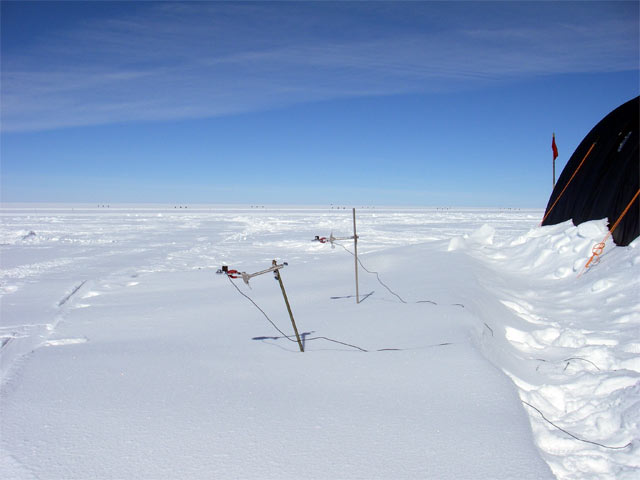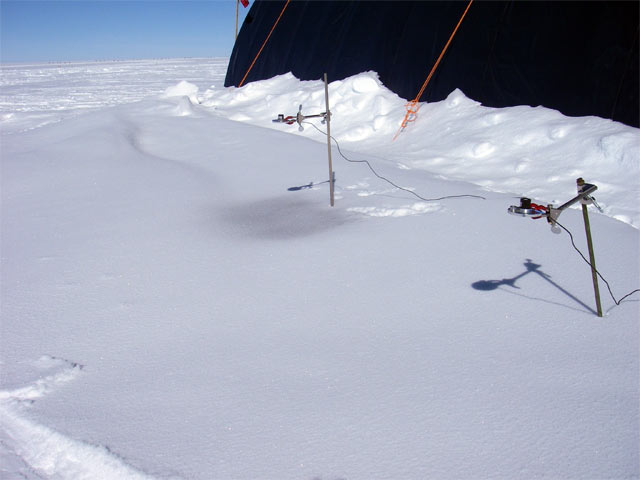( Log In ) Log In is for TREC Teachers & Researchers only
  |
| Kevin_McMahon |
 May 29 2006, 01:30 AM May 29 2006, 01:30 AM
Post
#1
|
 Advanced Member    Group: TREC Team Posts: 147 Joined: 12-April 06 Member No.: 25 |
High Temperature - 11 degrees Celsius
Low Temperature -29 degrees Celsius Clear Blue Skies How many 6th grade classes get to perform an experiment on top of the ice sheet in Greenland? My 6th grade students were curious about this question: How do the particles from air pollution effect the Greenland ice sheet? We designed an experiment to find out the answer to this question. The following journal entry will parallel the way we write about our experiments in our 6th grade classes. There are many new words and concepts used in this experiment. I hope you will try your best to understand them. Reply with questions if you are confused. QUESTION: How do the particles from the air pollution effect the Greenland ice sheet? HYPOTHESIS: Many 6th grade students thought that dark particles from air pollution that landed on the ice sheet might absorb more sunlight and cause the snow on the ice sheet to melt faster. These students thought this would happen because they know that they get hotter in the summer time when they wear a black t-shirt outside instead of a white t-shirt. PROCEDURE: We set up an experiment to measure how much sunlight was being reflected off clean snow and how much sunlight was being reflected off the “dirty” snow. We used sensors that measured the amount of the sun’s photons hitting the sensors. You can think of a photon as a particle that makes up light. To do the experiment, we followed these steps. Step 1. Setting Up Poles and Sensors. Mike Bergin and I got two sensors and two poles. We attached one sensor to each pole and set the poles into the snow. The sensors were attached to a data logger so that we could record our data. We made sure the sensors were working properly. See the photo below.  Two light sensors at Summit, Greenland. Step 2. One Sensor Pointing Up and One Sensor Pointing Down to Clean Snow. We pointed one sensor up into the air and pointed the other sensor down into clean snow. This step acted as our control. 6th graders, do you remember what a “control” is? If you do, reply to this teacher journal with the answer! We recorded measurements every minute for a five-minute period. Next, we recorded measurements every minute for a second 5-minute period. Step 3. One Sensor Pointing Up and One Sensor Pointing Down into “Dirty Snow.” After completing Step 2, Mike Bergin and I blackened the snow under the sensor that was pointing down. We used carbon soot to simulate air pollution particles. To blacken the snow we added two scoops of carbon soot to an empty spray bottle and then filled it to the top with water. We shook the spray bottle well and then sprayed the “air pollution particles” under the sensor that was pointing down. Just like our control, we recorded measurements each minute for two five-minute periods.  Mr. McMahon spraying dark particles onto the snow.  Can you see what sensor has "dirty" snow underneath it? DATA: Our sensors recorded the amount of “micromoles” of photons that hit them. For understanding this experiment, all you need to know is that micromole is a unit of measurement for the number of photons of light, just like a meter is a measure for how long something is. You also should know that the higher the number, the more light that is being reflected. Each of the numbers under the columns labeled sensor 1 and sensor 2 are measured in micromoles of photons. You also need to understand the word “albedo”. Albedo is just a fancy word for the measure of light that is reflected off a surface. To find this number, we divide the Sensor 2 number by the Sensor 1 number. The higher the albedo, the more light that is being reflected.   ANALYSIS OF DATA: The clean snow has more light reflecting off of it. It has an albedo ranging from 0.91 to 0.92. If you have a higher albedo number, it means that more light is reflecting off this surface. The dirty snow has a lower albedo. The dirty snow has an albedo ranging from 0.84 to 0.87. This means that more light was being absorbed by the dirty snow and less light was being reflected back into the atmosphere. There are many new words and concepts used in this experiment. I hope you tried your best to understand them. Reply with questions if you are confused. CONCLUSIONS: What conclusions can you make from this experiment? Does it seem like the “dirty” snow is absorbing more sunlight (since less light is being reflected back)? Is Greenland like a big white t-shirt for Earth, reflecting sunlight back into the atmosphere? What would happen if a lot of particles from air pollution land on the Greenland ice sheet? Let me know your thoughts. Whoa. That was a lot of information. You may need to read it again two or three times before it makes sense. Arctic Fact of the Day: A world championship of ice golf is played at Uummannaq, Greenland in mid-April when temperatures are around -8 degrees Celsius. Compared to normal golf, the balls are softer and red. The fairways are shorter and the holes are bigger. The holes are located on “whites” instead of “greens.” |
  |
2 User(s) are reading this topic (2 Guests and 0 Anonymous Users)
0 Members:

|
NSF Acknowledgment & Disclaimer | Time is now: 15th November 2024 - 07:01 PM |
Invision Power Board
v2.1.7 © 2024 IPS, Inc.








